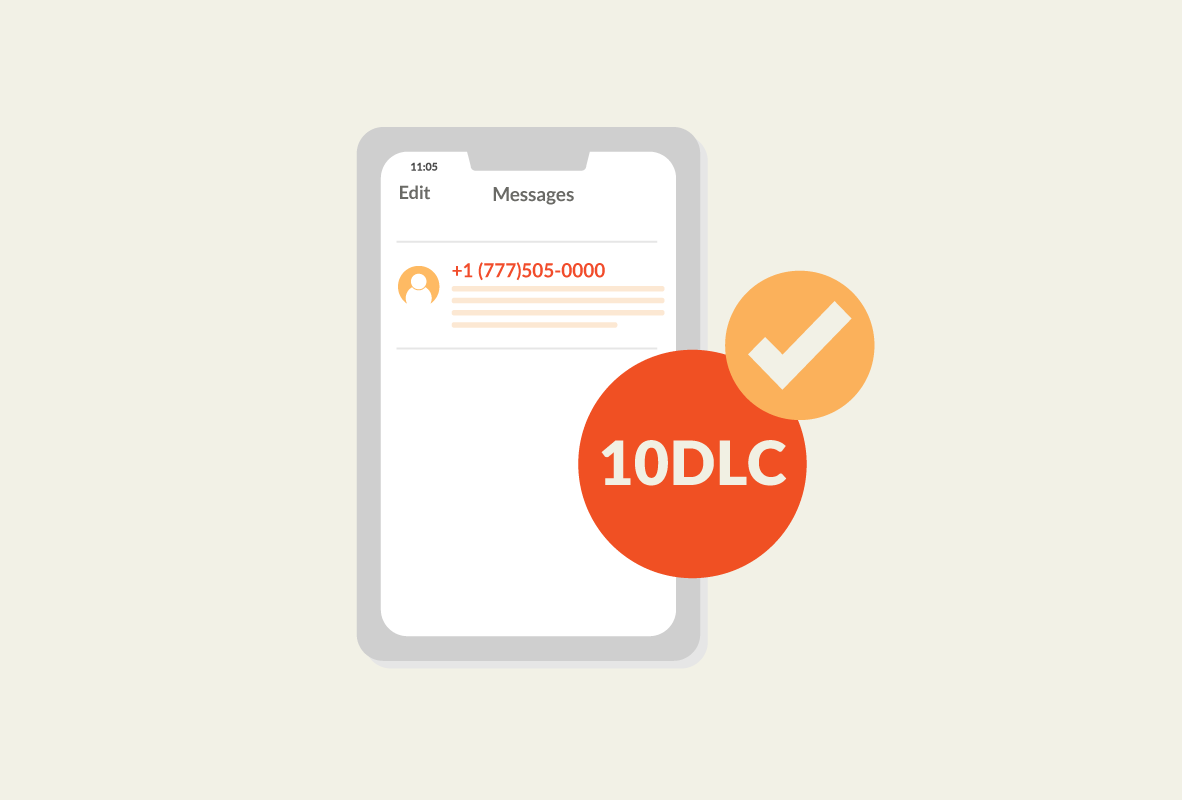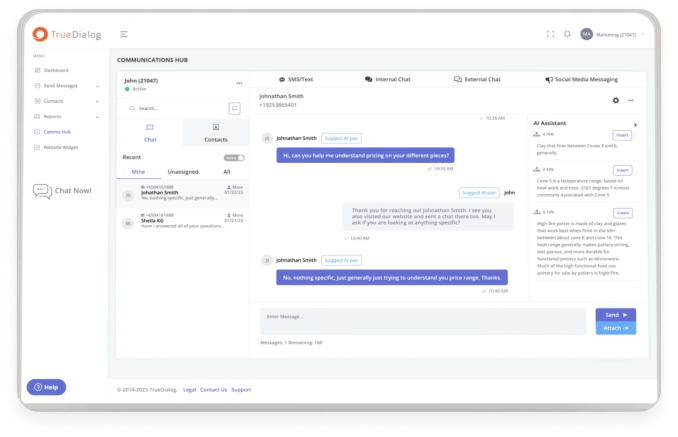Since its inception in 2019, 10DLC text messaging has expanded rapidly. The wide range of supported 10DLC use cases makes this newest application of SMS technology beneficial for businesses and organizations of all sizes.
The primary U.S. telecom carriers instituted 10DLC primarily to protect their customers from the growing problem of text message spam. It does this by requiring that all 10DLC users register their use cases with the industry’s official registration authority, The Campaign Registry (TCR). That registration allows carriers to track who is using their SMS service and for what purposes.
There are two categories of 10DLC use cases (generally called “campaigns”):
- Standard Campaigns: Use cases that fall into this category are typically pre-approved automatically by carriers and require no further vetting.
- Special Campaigns: These are sensitive or critical use cases that may require pre- or post-registration approval by carriers. This additional vetting and review can take up to several weeks.
Because important 10DLC parameters, such as message throughput and required fees, are tied to the type of campaign being run, it’s essential for businesses and other organizations that use text messaging to understand both 10DLC in general and 10DLC campaign use cases in particular.
What is 10DLC?
10DLC is an abbreviation for “10-digit long code,” which is the format of traditional 10-digit telephone numbers (723-123-4567, for example). 10-digit numbers were initially intended only for voice phone calls or P2P (person-to-person) texting. However, when some businesses began using 10-digit numbers for A2P (app-to-person) automated mass text message campaigns that consumers often perceived as spam, the North American telecom carriers introduced 10DLC to regulate the use of 10-digit numbers in text messaging. As TCR explains, an environment in which a high volume of spam messages is bad for End Customers, Brands, and the mobile industry overall… 10DLC is a sanctioned service that provides visibility into message sources and content and offers new benefits to message senders.
One great advantage of 10DLC is that organizations can use these numbers for voice calls and texting.
10DLC vs. Short Codes
Businesses can send SMS text messages using either Short Code or 10DLC. Each approach has its benefits.
Before the advent of 10DLC, businesses used short codes to mount automated, bulk, A2P marketing campaigns. Short codes allow consumers to contact a company by texting a keyword to a specified 5- or 6-digit number (e.g., “Text PIZZA to 12345”). They are designed for A2P texting and offer higher throughput than is possible with 10DLC. But costs are far higher and may amount to hundreds of dollars per month for each short code used.
Short codes are typically employed for high-volume mass marketing campaigns in which a single message is blasted to a broad audience. In contrast, while 10DLC can be used for mass marketing, it’s particularly suited to personalized, bi-directional interactions with individuals or small groups of recipients.
Related: Long Code vs. Short Code: Which Is Best for Your Business?
How 10DLC Works
To use 10DLC, an organization must register its brand and each campaign it intends to mount with TCR.
The brand registration associates the organization (as defined by its corporate name, address, tax number, etc.) with a specific brand name. TCR uses this information to assign the brand a Trust Score, which determines the costs it will incur for the text messages it sends and the message throughput rates available for each campaign.
In addition to this one-time brand registration, an organization must also register each campaign or use case it intends to run by specifying the types of messages it will send under that campaign. Message types include marketing messages, two-factor authentication codes, emergency alerts, etc. You can use up to 50 10DLC numbers per campaign.
Related: What 10DLC Is and How It’s Important to Mass Texting
Campaign Use Cases
As we’ve seen, whether standard or special, the type of campaign will determine the throughput rates and the fees associated with messages sent under that campaign. Let’s examine which use cases are associated with each campaign category.
Standard Use Cases
Standard 10DLC use cases are generally available to any brand qualified for registration with TCR and typically won’t require pre- or post-registration approval from carriers. Since these campaigns are pre-approved, they typically can be implemented immediately after registration. The message throughput rate for standard 10DLC use cases directly depends on the brand’s Trust Score. Standard 10DLC campaign use cases include:
- 2FA (Two-factor authorization): Passcodes used for authentication, verification, or access validation
- Account Notifications: Standard notifications for account holders relating to their account
- Customer Care: All customer care interactions, such as account management and customer support
- Delivery Notifications: Notifications of delivery status for a product or service
- Fraud Alert Messaging: Notifications concerning potential fraudulent activity in a customer’s account
- Higher Education: Messaging from school districts, colleges, universities, or other higher education institutions
- Low Volume Mixed: Messages from brands (typically test or demo accounts or small businesses such as a doctor’s office or pizza shop) that have multiple use cases with meager messaging throughput requirements
- Marketing: Messages with marketing or promotional content
- Mixed: Campaigns containing 2 to 5 standard use cases
- Polling and voting: Non-political surveys, polling, or voting campaigns
- Public Service Announcement: Informational messages that aim to raise an audience’s awareness about important issues
- Security Alert: Notifications that the security of a software or hardware system may have been breached, and immediate action is required
Special Use Cases
Special 10DLC use cases require vetting or approval by carriers but may provide higher message throughput and lower fees than standard use cases. Your actual message throughput will depend on your brand Trust Score and the specific use case you’re running. Because of the additional scrutiny applied to particular use cases, approval may require several weeks. Some special use cases are available only to specified types of organizations.
Special 10DLC campaign use cases include:
- Agents, franchises, and local branches: Messaging from organizations with independent agents, franchisees, or regional branch offices under their corporate umbrella but requiring individual numbers and messaging for each agent or franchise. Examples include insurance and real estate agencies with multiple locations and multiple agents who each engage in their text message communications. Only the brand’s corporate office, not any agents or sub-organizations, can register for this campaign.
- Charity / 501(c)(3) Nonprofit: Limited to registered 501(c)(3) nonprofit charities that provide help or raise money for those in need. Religious organizations are excluded. A check is made at registration to verify that the brand is registered as 501(c)(3) by the IRS.
- Emergency: Notifications that support public health and safety during emergencies. For example, a local government might send evacuation notices to the populace when a hurricane is approaching. This use case can only be used by city, county, state, or federal government entities and organizations working under contract with such entities.
- K-12 Education: Messaging that supports virtual learning and communication between students, teachers, and parents from grades K-12 and distance learning centers. Not for Post-Secondary schools.
- Political: Messaging is designed to aid organized groups in exerting political influence over specific target populations. For example, a party might send texts encouraging recipients to vote for their candidate. It can only be used by groups registered as 527, 501(c)(4), 501(c)(5), and 501(c)(6) nonprofits.
- Proxy: For peer-to-peer app-based group messaging with proxy or pooled numbers. Examples include companies like Airbnb, Uber, Lyft, Door Dash, etc.
- Social: Messages between public figures or media influencers and their followers. Examples include social media influencers and content creators messaging their followers.
- Sweepstakes: Sweepstakes-related messaging such as, for example, notification of prize giveaways at a local shopping center.
Before mounting any 10DLC text messaging campaign, you should carefully review the standard and special use case category descriptions and eligibility requirements to ensure that your messages meet the criteria for the associated use case.
Maximizing the Benefits of Business SMS
The key to getting maximum advantage from your text messaging campaigns is to use an SMS texting platform that provides a high degree of flexibility. You need an SMS texting software solution that can handle short codes and 10DLC while combining mass text messaging capabilities with the ability to conduct personalized two-way texting at scale.
TrueDialog’s robust and feature-rich text messaging platform embodies all those qualities and offers them in a highly user-friendly package. Please contact us today to schedule a demo to see how TrueDialog can take your SMS marketing outreach to new levels.





